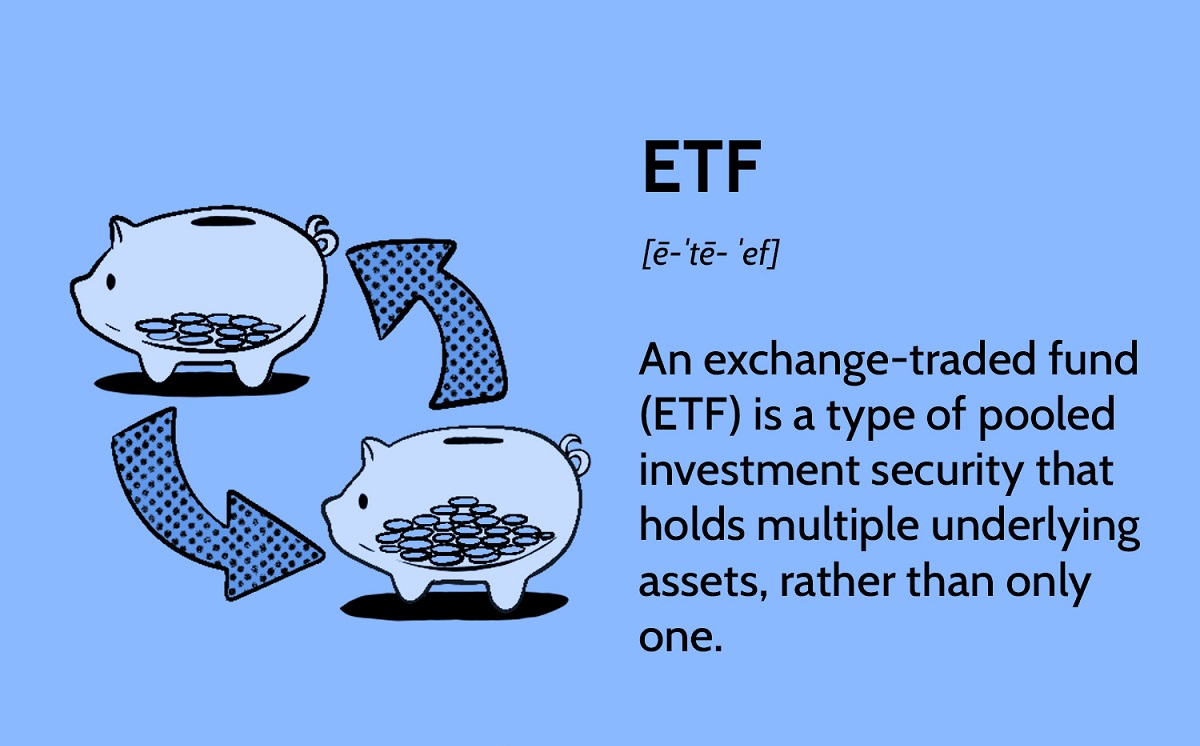Introduction
When it comes to investing your hard-earned money, making well-informed decisions is crucial. With the advancement of technology, there are now alternative methods to traditional investing that offer convenience and cost-effectiveness. Two popular options that have gained significant traction in recent years are robo advisors and S&P index funds.
A robo advisor is an automated investment platform that uses algorithms to manage and optimize your investment portfolio. On the other hand, an S&P index fund is a type of mutual fund or exchange-traded fund (ETF) that tracks the performance of the S&P 500 index, which is considered a benchmark for the overall U.S. stock market.
Both robo advisors and S&P index funds have their pros and cons, and understanding the differences between them can help you make a more informed decision about which option is best suited to your investment goals and preferences.
In this article, we will delve deeper into the world of robo advisors and S&P index funds, exploring their unique characteristics, advantages, and considerations for choosing between the two. So, whether you are a beginner investor or someone looking to diversify their investment strategy, read on to discover the benefits and drawbacks of each option.
What is a Robo Advisor?
A robo advisor is an automated investment platform that combines the power of technology and the expertise of financial advisors to provide personalized investment management services. These platforms utilize sophisticated algorithms and data analysis to create diversified portfolios and manage them on behalf of investors.
One of the key advantages of using a robo advisor is the accessibility it offers to individuals who may not have the time, knowledge, or large sums of money required for traditional investment management. With just a few clicks, investors can open an account, set their financial goals, and the robo advisor will handle the rest.
Robo advisors offer a range of investment options, including stocks, bonds, exchange-traded funds (ETFs), and more. By leveraging technology, they ensure that portfolios are well-diversified, matching the risk tolerance and investment objectives of each investor.
Another benefit of robo advisors is their cost-effectiveness. Traditional financial advisors often charge high fees for their services, which can eat into your investment returns over time. In contrast, robo advisors typically have lower fees due to their automated nature, making them an attractive option for cost-conscious investors.
Robo advisors also provide a streamlined user experience, allowing investors to track their portfolio performance, monitor their investments, and make adjustments as needed, all through a user-friendly online platform or mobile app. This convenience and transparency empower investors to have more control over their investments without the need for constant manual intervention.
However, it’s important to note that while robo advisors provide automated investment management, they may lack the personal touch and customized advice that a human financial advisor can provide. They may not take into account unique circumstances or provide guidance tailored to specific individual needs, which is something to consider when choosing between a robo advisor and a traditional financial advisor.
In summary, a robo advisor offers a technology-driven solution to investment management, providing accessibility, cost-effectiveness, and convenience to investors. While it may lack human interaction, its algorithms and automated processes make it an appealing option for those looking for a hands-off approach to investing.
What is an S&P Index Fund?
An S&P index fund is a type of mutual fund or exchange-traded fund (ETF) that is designed to track the performance of the Standard & Poor’s 500 Index, commonly known as the S&P 500. This index represents a broad selection of 500 large-cap U.S. companies that are publicly traded on the stock market.
The S&P 500 is widely regarded as a benchmark for the overall performance of the U.S. stock market, capturing approximately 80% of the overall market capitalization. It includes companies from various sectors, such as technology, finance, healthcare, and consumer goods, providing investors with exposure to a diversified range of industries.
Investing in an S&P index fund offers several advantages. Firstly, it allows investors to gain broad exposure to the U.S. stock market without the need to research and select individual stocks. By owning shares of the fund, investors indirectly own a portion of all the companies included in the S&P 500, spreading their investment risk.
Secondly, S&P index funds tend to have lower expense ratios compared to actively managed funds. Since the fund aims to replicate the index’s performance, there is less need for expensive research and portfolio management. This results in lower fees, allowing investors to keep a larger portion of their returns.
Additionally, S&P index funds have historically shown consistent and reliable performance over the long term. While there may be periods of volatility and fluctuations, the overall trend of the stock market has been positive. By investing in an S&P index fund, investors can participate in the market’s growth over time.
Another advantage of investing in an S&P index fund is the potential for tax efficiency. Since these funds generally have a low turnover rate, meaning they don’t frequently buy and sell stocks, there are fewer taxable events. This can result in lower capital gains taxes compared to actively managed funds.
It’s important to note that while S&P index funds offer broad diversification within the U.S. stock market, they do not provide exposure to other asset classes, such as international stocks, bonds, or alternative investments. Therefore, investors looking for a more diversified portfolio may need to consider additional investment options.
In summary, an S&P index fund is a type of investment vehicle that aims to replicate the performance of the S&P 500. It offers broad market exposure, low expenses, reliable long-term performance, and potential tax advantages. However, it may not provide the same level of diversification as a well-rounded portfolio.
Differences Between Robo Advisors and S&P Index Funds
While both robo advisors and S&P index funds offer convenient and cost-effective investment options, there are several key differences between the two:
- Investment Approach: Robo advisors use advanced algorithms to create and manage individualized investment portfolios based on an investor’s goals, risk tolerance, and preferences. They may allocate funds across various asset classes, including stocks, bonds, and ETFs, to achieve diversification. On the other hand, S&P index funds passively track the performance of the S&P 500 index and aim to replicate its returns. They do not actively manage the portfolio or make individual stock selections.
- Level of Automation: Robo advisors rely heavily on automation, utilizing algorithms and technology to handle investment decisions, rebalancing, and portfolio adjustments. S&P index funds, while also utilizing automation for tracking the index, may have some level of human involvement when it comes to fund management decisions.
- Customization: Robo advisors offer personalized investment strategies based on an investor’s risk tolerance and financial goals. Portfolios are constructed using a combination of asset allocation models and tax optimization strategies. S&P index funds, on the other hand, do not provide customization options as they are designed to replicate the performance of the underlying index for all investors.
- Cost Structure: Robo advisors typically charge a fee, often a percentage of the assets under management (AUM), for their services. The fees can vary depending on the platform and investment amount. S&P index funds usually have lower expense ratios compared to actively managed funds, making them a more cost-effective option.
- Human Interaction: Robo advisors generally provide limited human interaction, relying on digital interfaces and customer support teams for client communication. Some platforms may offer access to financial advisors for additional guidance. In contrast, investing in S&P index funds does not involve direct human interaction or personalized advice.
- Investment Horizon: Robo advisors can cater to both short-term and long-term investment strategies, depending on the individual’s goals. S&P index funds are often used as a long-term investment vehicle to achieve steady returns over time.
Understanding these differences can help investors determine which option aligns better with their investment preferences, financial goals, and level of involvement in the decision-making process.
Advantages of Using a Robo Advisor
Robo advisors offer several advantages that make them a compelling option for investors:
- Accessibility: Robo advisors make investing more accessible to a wider range of individuals. They eliminate the barrier of high minimum investment requirements, allowing people with smaller amounts of money to start investing.
- Cost-effectiveness: Robo advisors typically have lower fees compared to traditional financial advisors. This cost-effectiveness is due to the automation and streamlined processes of these platforms, which eliminates the need for human intermediaries and reduces overhead costs.
- Diversification: Robo advisors employ sophisticated algorithms to create well-diversified portfolios. They allocate investments across different asset classes and geographies, reducing the risk associated with investing in a single company or industry.
- Goal-based investing: Robo advisors allow investors to set specific financial goals, such as saving for retirement, buying a home, or funding a child’s education. The algorithms then tailor the investment strategy to align with these goals, maximizing the chances of achieving them.
- Automation and Efficiency: Robo advisors handle portfolio rebalancing, tax-loss harvesting, and other investment processes automatically. This automation ensures that the portfolio stays aligned with the investor’s goals and helps optimize tax efficiency, saving investors time and effort.
- Transparency: Robo advisors provide investors with transparent reporting and real-time access to their portfolio performance. They offer detailed information on holdings, fees, and investment strategies, allowing investors to stay informed and make data-driven decisions.
- Education and Support: Many robo advisors offer educational resources, such as articles, videos, and tutorials, to help investors enhance their financial knowledge. Additionally, customer support teams are available to answer questions and provide assistance when needed.
These advantages make robo advisors an attractive option for investors seeking a hands-off approach, cost-effective solutions, and access to sophisticated investment strategies. However, it’s important to carefully evaluate the features and offerings of different robo advisors to ensure they align with your specific financial goals and risk tolerance.
Advantages of Investing in an S&P Index Fund
Investing in an S&P index fund offers a range of advantages that have made it a popular choice among investors:
- Broad Market Exposure: S&P index funds provide investors with exposure to a diverse range of companies across various sectors of the U.S. economy. This broad market exposure allows for participation in the overall growth of the stock market.
- Low Fees: S&P index funds typically have lower expense ratios compared to actively managed funds. Since these funds aim to replicate the performance of the index rather than actively selecting stocks, there is less need for extensive research and management, resulting in lower costs.
- Consistent Performance: Over the long term, S&P 500 index funds have historically shown consistent and reliable performance. While short-term market fluctuations are inevitable, the overall trend of the stock market has been positive, providing investors with the potential for long-term growth.
- Tax Efficiency: Due to their passive nature, S&P index funds tend to have low turnover rates. This results in fewer taxable events and potentially lower capital gains taxes for investors compared to actively managed funds that frequently buy and sell stocks.
- Easy Diversification: By investing in an S&P index fund, investors gain exposure to a diversified portfolio of 500 large-cap companies, spanning various sectors. This diversification helps to reduce risk by spreading investments across multiple companies and industries.
- Accessibility: S&P index funds are widely available and accessible to individual investors through various investment platforms, including brokerage accounts and retirement accounts.
- Simplicity: Investing in an S&P index fund is straightforward. Once an investor has chosen a fund, they can easily buy shares and hold them for the long-term, without the need for complex investment decisions or continuous monitoring.
These advantages make S&P index funds an attractive choice for investors looking for broad market exposure, low fees, consistent performance, and ease of diversification. However, it’s important to note that index funds may not outperform actively managed funds during market upswings or in periods when specific sectors or industries are outperforming the broader market.
Factors to Consider When Choosing Between Robo Advisors and S&P Index Funds
When deciding between robo advisors and S&P index funds, there are several key factors that you should consider:
- Investment Goals: Evaluate your investment goals and determine whether they align more with the personalized approach offered by robo advisors or the broad market exposure provided by S&P index funds.
- Level of Involvement: Consider how involved you want to be in the investment process. If you prefer a hands-off approach and want the convenience of automated portfolio management, a robo advisor may be a better fit. On the other hand, if you prefer a simple “set it and forget it” strategy, an S&P index fund might be more suitable.
- Risk Preference: Assess your risk tolerance. Robo advisors offer customized portfolios based on risk tolerance levels, while S&P index funds provide exposure to the overall market’s risk and returns.
- Costs: Compare the fees associated with robo advisors and S&P index funds. Consider the management fees, expense ratios, and any additional charges associated with the platforms or funds.
- Access to Financial Advice: Determine whether you require personalized financial advice. Robo advisors typically offer limited human interaction, while S&P index funds do not provide personalized advice.
- Investment Horizon: Consider your investment timeline. Robo advisors can cater to both short-term and long-term goals, while S&P index funds are often considered a long-term investment vehicle.
- Portfolio Customization: Assess your desire for portfolio customization. Robo advisors allow for more personalized portfolio construction and adjustments, while S&P index funds offer a predetermined basket of stocks proportional to their weight in the index.
- Track Record: Evaluate the historical performance of robo advisors and S&P index funds. Consider the returns they have generated over time and compare them to industry benchmarks.
- Platform Features: Assess the features and capabilities of different robo advisor platforms or S&P index fund providers. Consider factors such as user experience, ease of use, accessibility, and available tools or resources.
By carefully considering these factors, you can make a more informed decision about whether a robo advisor or an S&P index fund aligns better with your investment experience, goals, and preferences.
Conclusion
When it comes to choosing between a robo advisor and an S&P index fund, there is no one-size-fits-all answer. Both options offer unique advantages and cater to different investment preferences and goals.
Robo advisors provide a technology-driven solution that offers accessibility, cost-effectiveness, diversification, and automation. They are ideal for those who prefer a hands-off approach, value convenience, and require personalized investment strategies.
On the other hand, S&P index funds provide broad market exposure, low fees, consistent performance, and ease of diversification. They are a suitable choice for investors seeking long-term growth, simplicity, and a passive investment approach.
When making your decision, consider factors such as your investment goals, risk tolerance, desired level of involvement, costs, access to financial advice, and time horizon. Each factor will play a crucial role in determining which option is best suited to your needs.
Ultimately, the decision between a robo advisor and an S&P index fund depends on your individual circumstances and preferences. You may also choose to combine both strategies to create a diversified portfolio that meets your specific investment objectives.
Remember to conduct thorough research, compare different platforms and providers, and consult with a financial professional if needed. This will ensure that you make an informed decision and embark on an investment strategy that aligns with your goals.

























